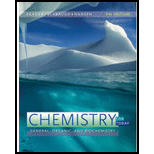
Bundle: Chemistry for Today: General, Organic, and Biochemistry, Loose-Leaf Version, 9th + LMS Integrated OWLv2, 4 terms (24 months) Printed Access Card
9th Edition
ISBN: 9781337598255
Author: Spencer L. Seager
Publisher: Cengage Learning
expand_more
expand_more
format_list_bulleted
Concept explainers
Question
Chapter 16, Problem 16.67E
Interpretation Introduction
Interpretation:
The molecular feature of bases of
Concept introduction:
The term DNA stands for deoxyribonucleic acid. Deoxyribonucleic acid is the most important
Expert Solution & Answer
Want to see the full answer?
Check out a sample textbook solution
Students have asked these similar questions
I have a bottle of butanal that has been improperly used by lab workers. They allowed a traceamount NaOH (aq) to contaminate the bottle. What is now in my bottle of “butanal? What is the molecular name and functional group name? Draw the structure.
Provide the missing information. *see image
First image: Why can't the molecule C be formed in those conditions
Second image: Synthesis for lactone C
its not an exam
Chapter 16 Solutions
Bundle: Chemistry for Today: General, Organic, and Biochemistry, Loose-Leaf Version, 9th + LMS Integrated OWLv2, 4 terms (24 months) Printed Access Card
Ch. 16 - Prob. 16.1ECh. 16 - Prob. 16.2ECh. 16 - Prob. 16.3ECh. 16 - Prob. 16.4ECh. 16 - Prob. 16.5ECh. 16 - Prob. 16.6ECh. 16 - Prob. 16.7ECh. 16 - Prob. 16.8ECh. 16 - Give each of the following amines an IUPAC name:...Ch. 16 - Give each of the following amines an IUPAC name....
Ch. 16 - Prob. 16.11ECh. 16 - Prob. 16.12ECh. 16 - Prob. 16.13ECh. 16 - Prob. 16.14ECh. 16 - Prob. 16.15ECh. 16 - Prob. 16.16ECh. 16 - Prob. 16.17ECh. 16 - Prob. 16.18ECh. 16 - Prob. 16.19ECh. 16 - Draw diagrams similar to Figure 16.1 to illustrate...Ch. 16 - Prob. 16.21ECh. 16 - Prob. 16.22ECh. 16 - Prob. 16.23ECh. 16 - Prob. 16.24ECh. 16 - Prob. 16.25ECh. 16 - Prob. 16.26ECh. 16 - Prob. 16.27ECh. 16 - Prob. 16.28ECh. 16 - Prob. 16.29ECh. 16 - Prob. 16.30ECh. 16 - Prob. 16.31ECh. 16 - Prob. 16.32ECh. 16 - Prob. 16.33ECh. 16 - Describe the general structure of a neuron.Ch. 16 - Name the two amino acids that are starting...Ch. 16 - Prob. 16.36ECh. 16 - Prob. 16.37ECh. 16 - Prob. 16.38ECh. 16 - Prob. 16.39ECh. 16 - Prob. 16.40ECh. 16 - Prob. 16.41ECh. 16 - Prob. 16.42ECh. 16 - Why are alkaloids weakly basic?Ch. 16 - Prob. 16.44ECh. 16 - Prob. 16.45ECh. 16 - Prob. 16.46ECh. 16 - Prob. 16.47ECh. 16 - Prob. 16.48ECh. 16 - Prob. 16.49ECh. 16 - Prob. 16.50ECh. 16 - Prob. 16.51ECh. 16 - Complete the following reactions: a. b.Ch. 16 - Complete the following reactions: a. b.Ch. 16 - Prob. 16.54ECh. 16 - What are the products of the acid hydrolysis of...Ch. 16 - Prob. 16.56ECh. 16 - Prob. 16.57ECh. 16 - Prob. 16.58ECh. 16 - Prob. 16.59ECh. 16 - Prob. 16.60ECh. 16 - Prob. 16.61ECh. 16 - Prob. 16.62ECh. 16 - Prob. 16.63ECh. 16 - Prob. 16.64ECh. 16 - Prob. 16.65ECh. 16 - Prob. 16.66ECh. 16 - Prob. 16.67ECh. 16 - Prob. 16.68ECh. 16 - Prob. 16.69ECh. 16 - Prob. 16.70ECh. 16 - Prob. 16.71ECh. 16 - The stimulant in coffee is: a. tannic acid b....Ch. 16 - What are the most likely products of a reaction...
Knowledge Booster
Learn more about
Need a deep-dive on the concept behind this application? Look no further. Learn more about this topic, chemistry and related others by exploring similar questions and additional content below.Similar questions
- First image: I have to show the mecanism for the reaction on the left, where the alcohol A is added fast in one portion Second image: I have to show the mecanism of the reaction at the bottom. Also I have to show by mecanism why the reaction wouldn't work if the alcohol was primaryarrow_forwardFirst image: I have to explain why the molecule C is never formed in those conditions. Second image: I have to propose a synthesis for the lactone Aarrow_forwardFirst image: I have to explain why the molecule C is never formed in these conditions Second image: I have to propose a synthesis for the lactone Aarrow_forward
- help 20arrow_forwardProvide the drawing of the unknown structure that corresponds with this data.arrow_forward20.44 The Diels-Alder reaction is not limited to making six-membered rings with only car- bon atoms. Predict the products of the following reactions that produce rings with atoms other than carbon in them. OCCH OCCH H (b) CH C(CH₂)s COOCH མ་ནས་བ (c) N=C H -0.X- (e) H C=N COOCHS + CH2=CHCH₂ →→arrow_forward
arrow_back_ios
SEE MORE QUESTIONS
arrow_forward_ios
Recommended textbooks for you
- Chemistry: Matter and ChangeChemistryISBN:9780078746376Author:Dinah Zike, Laurel Dingrando, Nicholas Hainen, Cheryl WistromPublisher:Glencoe/McGraw-Hill School Pub Co
 General, Organic, and Biological ChemistryChemistryISBN:9781285853918Author:H. Stephen StokerPublisher:Cengage Learning
General, Organic, and Biological ChemistryChemistryISBN:9781285853918Author:H. Stephen StokerPublisher:Cengage Learning Organic And Biological ChemistryChemistryISBN:9781305081079Author:STOKER, H. Stephen (howard Stephen)Publisher:Cengage Learning,
Organic And Biological ChemistryChemistryISBN:9781305081079Author:STOKER, H. Stephen (howard Stephen)Publisher:Cengage Learning,  ChemistryChemistryISBN:9781305957404Author:Steven S. Zumdahl, Susan A. Zumdahl, Donald J. DeCostePublisher:Cengage Learning
ChemistryChemistryISBN:9781305957404Author:Steven S. Zumdahl, Susan A. Zumdahl, Donald J. DeCostePublisher:Cengage Learning Chemistry: An Atoms First ApproachChemistryISBN:9781305079243Author:Steven S. Zumdahl, Susan A. ZumdahlPublisher:Cengage Learning
Chemistry: An Atoms First ApproachChemistryISBN:9781305079243Author:Steven S. Zumdahl, Susan A. ZumdahlPublisher:Cengage Learning

Chemistry: Matter and Change
Chemistry
ISBN:9780078746376
Author:Dinah Zike, Laurel Dingrando, Nicholas Hainen, Cheryl Wistrom
Publisher:Glencoe/McGraw-Hill School Pub Co

General, Organic, and Biological Chemistry
Chemistry
ISBN:9781285853918
Author:H. Stephen Stoker
Publisher:Cengage Learning

Organic And Biological Chemistry
Chemistry
ISBN:9781305081079
Author:STOKER, H. Stephen (howard Stephen)
Publisher:Cengage Learning,

Chemistry
Chemistry
ISBN:9781305957404
Author:Steven S. Zumdahl, Susan A. Zumdahl, Donald J. DeCoste
Publisher:Cengage Learning

Chemistry: An Atoms First Approach
Chemistry
ISBN:9781305079243
Author:Steven S. Zumdahl, Susan A. Zumdahl
Publisher:Cengage Learning

Biomolecules - Protein - Amino acids; Author: Tutorials Point (India) Ltd.;https://www.youtube.com/watch?v=ySNVPDHJ0ek;License: Standard YouTube License, CC-BY